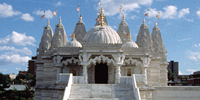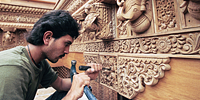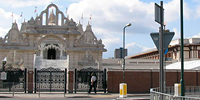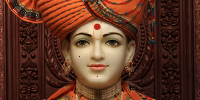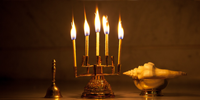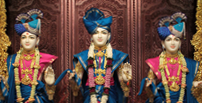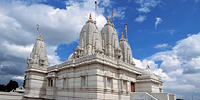Arti: The Hindu Ceremony of Light
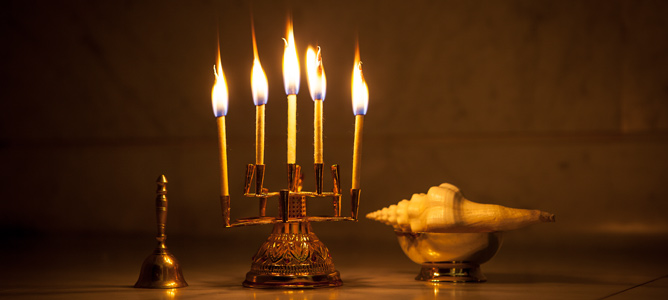
The arti (pronounced ‘aarti’) is one of the most important and popular ceremonies of the Hindu faith. It is a prayerful ceremony performed in extolled greeting and thanksgiving of the Deities where devotees are reminded of God’s glorious presence and providence.
Origin
The arti ceremony is said to have descended from the ancient Vedic concept of fire rituals, or homa.
Others attribute it to the practice many centuries ago of illuminating a murti set deep inside the dark recess of a mandir’s cave-like inner sanctum. To allow devotees darshan of the sacred image, the priest would wave an oil lamp from the Deity’s head to toe while chanting Vedic mantras or singing a prayer. Gradually, the practice developed into the arti.
Meaning
In Sanskrit, the word ‘arti’ – transcribed as ‘aarati’ – is composed of the prefix ‘aa’, meaning complete, and ‘rati’, meaning love. The arti is thus an expression of one’s complete and unflinching love towards God. It is sung and performed with a deep sense of reverence, adoration, and meditative awareness.
Practice
Often called the ‘ceremony of light’, the arti involves waving lighted wicks before the sacred images to infuse the flames with the Deities’ love, energy and blessings. It is performed by sadhus (Hindu monks) and pujaris (attendants to the Deities).
Along with – or sometimes instead of – flames from ghee-soaked wicks, the light from camphor is also used. Other auspicious articles offered during the ceremony include incense, water, and flowers. Some artis also involve the waving of a chamar (wisp) or white cloth. These together represent the five elements of the world – 1) space (white cloth), 2) air (wisp), 3) light (flames), 4) water, and 5) earth (flowers) – and symbolise the offering of the whole of creation to the Deity during the arti ceremony.
The term ‘arti’ also refers to the prayer sung in praise of the Deity while the wicks are waved. This prayer is joyously sung to the accompaniment of musical instruments, including drums, bells, gongs, and a conch-shell. In fact, the ceremony is often announced and concluded by the blowing of a conch-shell. The pujari also rings a small hand-bell while waving the wicks and singing the prayer.
After the short prayer, the lighted wicks are passed around the congregation to allow members to receive the blessings infused within the flames. Members hover their down-turned hands over the flame and then reverently touch them to their eyes and head. The purificatory blessing, conveyed from the Deities to the flame, has now been passed on to the devotee.
The arti is usually performed five times during the day at shikharbaddha (large, spired) mandirs with each arti relating to a specific part of the Deities’ routine. The five most common artis are:
|
Name |
Meaning |
Significance |
Approx. Time |
|---|---|---|---|
|
Mangala Arti |
‘auspicious’ |
When the Deities offer the first darshan of the day, signifying the auspicious beginning of the day for devotees |
Dawn |
|
Shangar Arti |
‘adornments’ |
When the Deities are dressed and adorned |
Early Morning |
|
Rajbhog Arti |
‘royal offering’ |
After the Deities have been offered their midday meal |
Midday |
|
Sandhya Arti |
‘evening’ |
When the Deities offer their special evening audience |
Dusk |
|
Shayan Arti |
‘sleeping’ |
When the Deities are about to retire for the night |
Late Evening |
At smaller mandirs and in shrines at devotees’ homes, the arti is performed twice daily, in the morning and the evening.
The arti also features as a component of other, more elaborate rituals within Hindu worship, and is often the concluding prayer in religious assemblies and festivals.
Significance
Like other Hindu rituals, the arti has profound spiritual sentiments underlying it.
Just as the wicks burn in the service of the Deities, devotees pray that they, too, can selflessly offer themselves in the service of God.
And as the wicks eventually burn themselves out, devotees pray their ego can similarly be eradicated through such service and humble worship.
Furthermore, just as the wicks provide light and dispel darkness, only the true knowledge of God and the guru can dispel ignorance and false understanding.
Resources
The words of the Swaminarayan arti sung at BAPS Hindu mandirs around the world and an English translation of it can be found here. Or click here to listen to the Swaminarayan arti being sung to the accompaniment of musical instruments.
